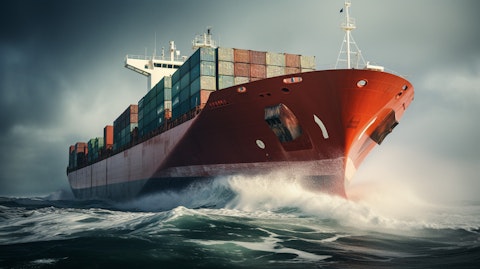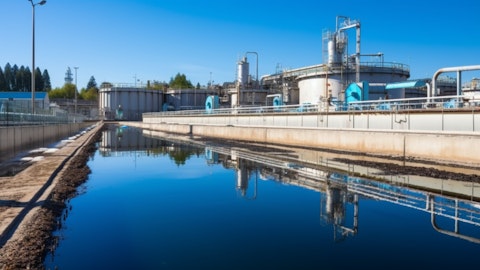Genco Shipping & Trading Limited (NYSE:GNK) Q3 2025 Earnings Call Transcript November 6, 2025
Operator: Good morning, ladies and gentlemen, and welcome to the Genco Shipping & Trading Limited Third Quarter 2025 Earnings Conference Call and Presentation. Before we begin, please note that there will be a slide presentation accompanying today’s conference call. That presentation can be obtained from Genco’s website at www.gencoshipping.com. To inform everyone, today’s conference is being recorded and is now being webcast at the company’s website, www.gencoshipping.com. [Operator Instructions] A webcast replay will also be available via the link provided in today’s press release as well as the company’s website. At this time, I will now turn the conference over to the company. Please go ahead.
Peter Allen: Good morning. Before we begin our presentation, I note that in this conference call, we will be making certain forward-looking statements pursuant to the safe harbor provisions of the Private Securities Litigation Reform Act of 1995. Such forward-looking statements use words such as anticipate, budget, estimate, expect, project, intend, plan, believe and other words and terms of similar meaning in connection with the discussion of potential future events, circumstances or future operating or financial performance. These forward-looking statements are based on management’s current expectations and observations. For a discussion of factors that could cause results to differ, please see the company’s press release that was issued yesterday, the materials relating to this call posted on the company’s website and the company’s filings with the Securities and Exchange Commission, including, without limitation, the company’s annual report on Form 10-K for the year ended December 31, 2024, and the company’s reports on Form 10-Q and Form 8-K subsequently filed with the SEC.
At this time, I’d like to introduce John Wobensmith, Chairman and CEO of Genco Shipping & Trading Limited.
John Wobensmith: Good morning, everyone. Welcome to Genco’s third quarter 2025 conference call. I will begin today’s call by reviewing our Q3 2025 and year-to-date highlights. Additionally, we will provide an update on our value strategy, discuss our financial results for the quarter as well as the industry’s current fundamentals before opening the call up for questions. For additional information, please also refer to our earnings presentation posted on our website. Starting on Slide 5. During the third quarter, we continued to advance our value strategy, prioritizing returning cash to shareholders through market cycles and taking additional steps to further expand our earnings power for the benefit of shareholders. For the third quarter, we declared a dividend of $0.15 per share despite an intensive drydocking quarter, extending our track record of 25 quarters of consecutive dividends and marking the longest period of uninterrupted dividends in our drybulk peer group.
Including the Q3 dividend, Genco has declared $7.065 in dividends per share, representing 43% of our current share price. In terms of Genco’s ability to capitalize on a strong freight market, we remain optimistic for the remainder of 2025 and into 2026. By the start of Q4, we have completed 90% of our drydocking schedule for the year, which positions us well to maximize utilization in what has been a strong Q4 to date. Specifically, our Q4 TCE is currently estimated to be up more than 25% to over $20,000 per day on a fleet-wide basis for 72% of the quarter with strong freight rates being achieved by both our Capesize vessels at approximately $27,000 per day as well as our minor bulk fleet at approximately $16,000 per day. These rates compare favorably to our Q4 cash flow breakeven rate, which is estimated to be approximately $10,000 per day and represents an industry low breakeven rate.
In October, we took delivery of a 2020-built Capesize vessel, adding a modern high-specification vessel to our fleet during a seasonally strong point in the freight market. Notably, our first fixture on the vessel following delivery was booked for $29,000 per day net over 50 days, immediately generating earnings while also derisking the investment. This vessel acquisition represents the fourth high-specification fuel-efficient Capesize vessel that Genco has agreed to acquire since Q4 of 2023, further expanding the company’s presence in a key sector with compelling supply and demand fundamentals. Moving on to Slide 6. When we implemented our value strategy in April 2021, we set out to accomplish 3 main objectives: transfer Genco into a low leverage, high dividend company, maintain significant flexibility for growth and pay a quarterly dividend based on cash flows less a voluntary quarterly reserve.
Four years later, we are pleased to have made progress on each of these objectives. We have implemented a well-balanced capital allocation strategy, successfully capitalized on compelling vessel acquisitions, provided shareholders with uninterrupted dividends and opportunistically paid down debt. Specifically, over the past 4 years, we have invested nearly $347 million in high-quality modern vessels, distributed $264 million in dividends to shareholders and paid down $279 million in debt. Collectively, these actions have enabled Genco to establish a balance sheet that is built to effectively operate in a volatile market, create a highly differentiated risk/reward balance and increase the earnings power of the company to continue to pay regular quarterly dividends and create enduring long-term shareholder value.
On Page 7, we highlight our fleet composition. We currently own a fleet of 17 Capesize vessels and 26 Ultramax and Supramax vessels. We continue to balance the high beta and the upside potential of the Capesize sector, along with the steadier earnings stream of the minor bulk ships. On a vessel ownership basis, our ownership splits are 40% Capes and 60% Ultras/Supras. However, when we view these splits on an asset value or net revenue basis, we are over 50% weighted towards the Capesize vessels, providing us significant operating leverage. Turning to Slide 8. With an industry low net loan-to-value ratio, a low cash flow breakeven rate and $430 million in undrawn revolver availability, we believe Genco remains in a highly advantageous position to successfully operate in the current volatile freight rate environment and continue to differentiate itself from its dry bulk peer group.
Genco has the scale and operating leverage to benefit from a rising market while also having significant access to capital to take advantage of opportunities if they were to arise as we’ve demonstrated throughout the cycle. Going forward, we remain focused on executing the 3 pillars of our value strategy, dividends, deleveraging and growth. Importantly, as we progress through the fourth quarter and position Genco for 2026, we do so with the majority of our drydock schedule complete, a further reduced cash flow breakeven level and significant operating leverage to capitalize on improving drybulk fundamentals. Lastly, turning to Page 9. Genco continues to prioritize strong corporate governance, which we believe is another key differentiator for the company relevant to the peer group.
Specifically, Genco is the only listed drybulk shipping company with no related party transaction. We have a diverse and independent Board of Directors are highly transparent and provide detailed disclosures on company performance and initiatives while striving to provide a clear and thoughtful strategy to shareholders as we execute on our approach to capital allocation. We view this as a key part of Genco’s identity as a company. I will now turn the call over to Peter Allen, our Chief Financial Officer.

Peter Allen: Thank you, John. On Slides 11 through 14, we highlight our third quarter financial results. Genco recorded a net loss of $1.1 million or $0.02 basic and diluted net loss per share. Adjusted net loss was $0.01 per share, excluding a loss on debt extinguishment of $0.7 million. Adjusted EBITDA for Q3 totaled $21.7 million, an increase of 52% as compared to Q2. Our cash position as of September 30 was $90 million, which increased due to a drawdown of debt in the third quarter for the purchase of the Genco Courageous, which delivered in the fourth quarter. Our debt outstanding also increased to $170 million due to this purchase. The final installment representing 90% of the purchase price or $57.2 million was funded in October.
Overall, since 2021, we have reduced our cash — our debt balance from $450 million down to the current $170 million level, a reduction of 62%. Pro forma for this acquisition, our net loan-to-value is approximately 12%. Furthermore, our undrawn revolver availability is currently $430 million. With our full revolving credit facility structure, we plan to continue to actively manage our cash and debt positions to reduce interest expense while maintaining access to capital to quickly act on growth opportunities as we did with our most recent acquisition of a high-specification fuel-efficient Capesize vessel. Moving to Slide 15, we highlight our quarterly dividend policy, which targets a distribution based on 100% of operating cash flow less a voluntary reserve.
For Q3, our Board of Directors declared a $0.15 per share dividend based on operating cash flow of approximately $21.5 million and a voluntary quarterly reserve of $14.9 million. Notably, for the third quarter of 2025, our dividend formula, including a voluntary reserve of $19.5 million, would have produced a $0.05 per share dividend. However, on management’s recommendation, the Board chose to reduce the voluntary reserve to $14.9 million for the quarter, resulting in the $0.15 per share dividend. This highlights our commitment to regular shareholder returns as well as our favorable view on the long-term fundamentals of the drybulk industry and the seasonally stronger freight rate environment that has emerged in the second half of this year.
Looking ahead to Q4 2025, we currently have 72% of owned available days fixed at approximately $20,000 per day as compared to our anticipated cash flow breakeven rate, excluding drydocking-related CapEx of approximately $9,000 per vessel per day. Our TCE has increased each quarter of this year and Q4 TCE estimates are currently projected to not only be the highest TCE of the year, but the highest quarterly level since 2022, highlighting the freight rate improvement seen in the second half of this year thus far. Notably, this improvement has been led by our Capesize vessels, which in Q4 to date are currently fixed at approximately $27,000 per day, an increase of nearly 30% from $21,000 per day in Q3, further highlighting the significant operating leverage of the sector.
We note that Genco, like much of the industry, has a large-scale drydocking program in 2025. Through the first 9 months of the year, we have completed 16 of 19 scheduled drydockings with one more completed in early November. This resulted in Genco completing 90% of our full year 2025 drydockings with only 2 drydockings remaining as we look to maximize utilization in Q4. We believe Genco’s high operating leverage as displayed in the second half of this year, combined with our low financial leverage, creates a solid risk/reward balance for shareholders while providing Genco with increased optionality for the company. I will now turn the call over to Michael Orr, our drybulk market analyst, to discuss industry fundamentals.
Michael Orr: Thank you, Peter. Beginning on Slide 17, the drybulk freight rate environment meaningfully improved in Q3 and into Q4 to date as compared to earlier in the year levels. Capesize rates were driven by all-time high Brazilian iron ore shipments during the quarter, including exceeding 40 million tons of both July and August for the first time on record. Brazilian iron ore miner, Vale also reported their highest quarterly production since 2018. Supramax rates were led by augmented coal shipments to China as the country’s domestic coal output declined during a period of strong demand. Furthermore, increased South American grain shipments were also supportive for the smaller class vessels. These factors resulted in the Baltic Capesize Index and Baltic Supramax Index to average approximately $26,000 and $14,000 per day, respectively, in Q3.
Turning to Page 18, we point to China’s strong level of iron ore imports in recent months, led by increased seaborne supplies together with the restocking of iron ore inventories. Specifically, the country’s iron ore imports in Q3 rose by 6% year-over-year after a softer first half. While China’s iron ore stockpiles were drawn down as much as 8% in the year-to-date, stockpiles have now increased by 6% off of the [ 2025 lows ]. China’s steel production has decreased year-over-year by 3%, while China continues to export over 10% of the steel produces mostly going to other Asian countries. Turning to Page 19, we highlight the long-haul iron ore and bauxite trade growth expected from Brazil and West Africa in the coming years. While the growth this year is expected to be marginal with first shipments likely to materialize in November, there are significant growth volumes expected in the coming years.
Given the scale of the project, these volumes could absorb potentially over 200 Capesize vessels, which is more than the current Capesize newbuilding order book. Supply constraints and Capesize newbuilding activity combined with added long-haul train distances are 2 key catalysts for the sector. In terms of the grain trade as detailed on Page 20, China has reportedly purchased at least 4 U.S. soybean cargoes following the meeting of President Trump and President [ Xi ] last week. China has agreed to purchase a minimum of 25 million tons of soybeans per year from the U.S. over the next 3 years. Prior to the summit, China had not purchased any U.S. soybean cargoes as they had ramped up purchases of Brazilian agricultural products for much of the year.
Regarding the supply side outlined on Slide 21, net fleet growth in the year-to-date is 3% on an annualized basis, split between 1% net fleet growth for Capesizes and 4% to 5% net fleet growth for Panamaxes down to Handysize. The Capesize segment continues to have the smallest order book among the drybulk sectors at 9% of the fleet. Additionally, as scrapping has remained low in recent years, the age of the global fleet has risen to nearly 13 years old, the highest average age of the global drybulk fleet since 2010. This has increased the pool of potential scrapping candidates as over 10% of the on-the-water fleet is 20 years or older, which is identical to the global drybulk order book as a percentage of the fleet. This implies net replacement of tonnage over time as opposed to any material net fleet growth.
While we expect volatility in the freight market, the foundation of a low supply growth picture provides a solid basis for our constructive view of the drybulk market going forward. This concludes our presentation, and we would now be happy to take your questions.
Q&A Session
Follow Genco Shipping & Trading Ltd (NYSE:GNK)
Follow Genco Shipping & Trading Ltd (NYSE:GNK)
Receive real-time insider trading and news alerts
Operator: [Operator Instructions] Your first question comes from the line of Omar Nokta with Jefferies.
Omar Nokta: Just wanted to get maybe just a sense, I know you talked about it a bit, but just sort of in terms of what we’re seeing in the freight market, it looks like we’ve been building on this improvement that was — you first were talking about back in August when you reported 2Q results. Capes have gotten stronger. We’ve seen the Panamax and Supramax segments have all started lifting here into year-end. I just wanted to get a sense from your perspective, is this a seasonality thing? Or is this something much bigger? Is it Simandou? How would you characterize sort of this improvement that we’ve just been continuing to see here in the second half?
John Wobensmith: Yes, Omar. So I think it’s sort of all of the above in the sense that, yes, it’s seasonal. We typically have a late Q3, Q4 stronger freight market. But this time around, we’re also seeing record Brazilian iron ore exports in the second half. That obviously has been very positive because of the long-haul ton-mile creation nature of that. And we’ve had an increase on the coal trades. China domestic demand has increased when domestic coal production actually has gone down. There’s been a strong grain trade driven by South America on the minor bulk side, a lot of soybeans being bought by the Chinese really in record quantities at this point. And then we’ve also had the USTR with the self-sanctioning, which really reduced some of the tonnage count in the Atlantic, which we’ve been able to actually take full advantage of.
Omar Nokta: Yes. So it seems like, as you said, just a handful of things coming together. And then maybe just on that — as a follow-up, just on that final point you brought up the USTR, the China fees that went into effect briefly against U.S. shipping. Those have now been postponed for 12 months. Just want to get a sense, how did that affect things, I guess, from your view in terms of how it affected, say, drybulk rates, that the Chinese fees? And then how did it affect Genco?
John Wobensmith: So from affecting revenues and affecting Genco, it’s completely immaterial. Affecting the management team, we, as I like to say, had a lost weekend, that Columbus Day weekend because we spent an inordinate amount of time diverting ships. We had 4 ships that were going in. And so — but we were able to successfully divert those vessels to different discharge ports. And then, of course, Monday of Columbus Day weekend, the Chinese clarified the port fee side of it and it will allow U.S. companies to come in with Chinese-built vessels and not have any port fees. Of course, 80% of our fleet is Chinese-built. So that was — that took a lot of risk off the table. And we — even if those port fees had remained in place, we’re really talking about 7 to 8 Capesize vessels that we had already worked out a way to trade those ships at the same earnings level as they’re trading now.
Good news is all of that’s been taken off the table for at least a year, but we’re well prepared if that comes back into effect for some reason.
Omar Nokta: Okay. Yes. So if indeed it does come back in 12 months’ time, it seems like it’s a fairly negligible impact on Genco.
John Wobensmith: It’s just a change of strategy a little bit. I mean our minor bulks are trading very much so in the Atlantic anyway and not doing a lot of Chinese business. And on the Capes, as I said, there are plenty of other trades on the Capes that the 7 or 8 that we have that are Japanese and South Korean-built, we’ll find alternative employment without any material impact on the company.
Operator: Your next question comes from the line of Liam Burke with B. Riley Securities.
Liam Burke: John, you’ve been investing in the Capesize on the investments. But do you have a look at the non-Capesize? Or is it just the asset coming online that’s attractive and gives you the proper return?
John Wobensmith: Yes. So look, we have a strong minor bulk fleet. We continue to operate that, and we have no plans to divest out of minor bulks. We have quite a commercial operating platform there. But when we look at the market as a whole, and we look at the low order book, which Michael Orr pointed out at a little more than 10% versus ships that are 20 years and older overall basically match that number. So there is no fleet growth that is anticipated at least now for the drybulk industry as a whole. The Capesize sector has better supply dynamics and being much lower than on the minor bulk side. And when we couple that with the demand growth that we see coming, particularly out of West Africa, but also I think Vale is going to have some growth as well, and there’ll be some further growth on the bauxite trade.
But that Simandou and the tonnage that is really going to ramp up, we think, in the second half of next year also creates demand growth. So low supply and demand growth, that bodes well for the sector, and that’s why we’re focused in terms of acquisitions more on the larger vessels than the midsize.
Liam Burke: Great. With your fleet renewal, your debt balance has moved up to finance the asset acquisitions. Outside of fleet renewal, do you anticipate accelerating that debt reduction as you’re seeing strong cash flows on the higher rates?
John Wobensmith: Look, we have a dividend formula in place. So we will definitely be sticking to that. We have a reserve of a little less than $20 million a quarter that’s built into that. We think that is sufficient at this point. So I see us continuing to do fleet renewal. And as I said, we here before, we’re concentrated right now anyway on the larger vessels.
Operator: [Operator Instructions] Your next question comes from the line of Michael Mathison with [ Sidoti ].
Michael Mathison: Congratulations on the demand growth. I just had a question regarding Chinese demand for coal. You mentioned that their demand is up. Have you seen any signs of switching the source of their imports from the U.S. to Brazil or other providers?
John Wobensmith: Yes. I think because of the USTR, we’ve seen less — a lot less coal come out of the U.S., and it has come from other areas. From a ton-mile standpoint, I would say it’s been fairly neutral, but we do expect U.S. coal exports to tick up in the next 6 months because of USTR going away. And I think the — I think there’s also a push in the U.S. right now by the current administration to beef up coal export. So we do expect to see some growth again in that area.
Operator: Your final question comes from the line of Poe Fratt with AGP, Alliance Global Partners.
Charles Fratt: John, you — on Page 9 of your presentation, you highlight your corporate governance and how it’s very strong and the best in the industry. Can you just give us a reason for adopting a poison pill in early October?
John Wobensmith: Yes. I mean I think it’s — we had a shareholder that quickly accumulated a little less than a 15% position. And so as all poison pills, we want to do what’s right for all shareholders. And so what that means is that we can slow things down so that we can make sure that if there is something to be done, that again, we can get the best transaction for shareholders. And we also — I’ll add, we did it in the most shareholder-friendly way in that we put it in place for just less than a year, and we spent a lot of time on structuring that, again, to be as shareholder-friendly as we could.
Charles Fratt: Would you categorize the move, John, as preemptive? Or was it in response to signals from the largest shareholder?
John Wobensmith: No, I would characterize it only to the speed in which the 15% was acquired. And again, if there was any process, you want to slow it down. And again, the idea is to maximize value for all shareholders, and that can be accomplished by putting that in place.
Operator: There are no further questions at this time. This concludes your conference call for today. We thank you for participating and ask that you please disconnect your lines.
Follow Genco Shipping & Trading Ltd (NYSE:GNK)
Follow Genco Shipping & Trading Ltd (NYSE:GNK)
Receive real-time insider trading and news alerts



